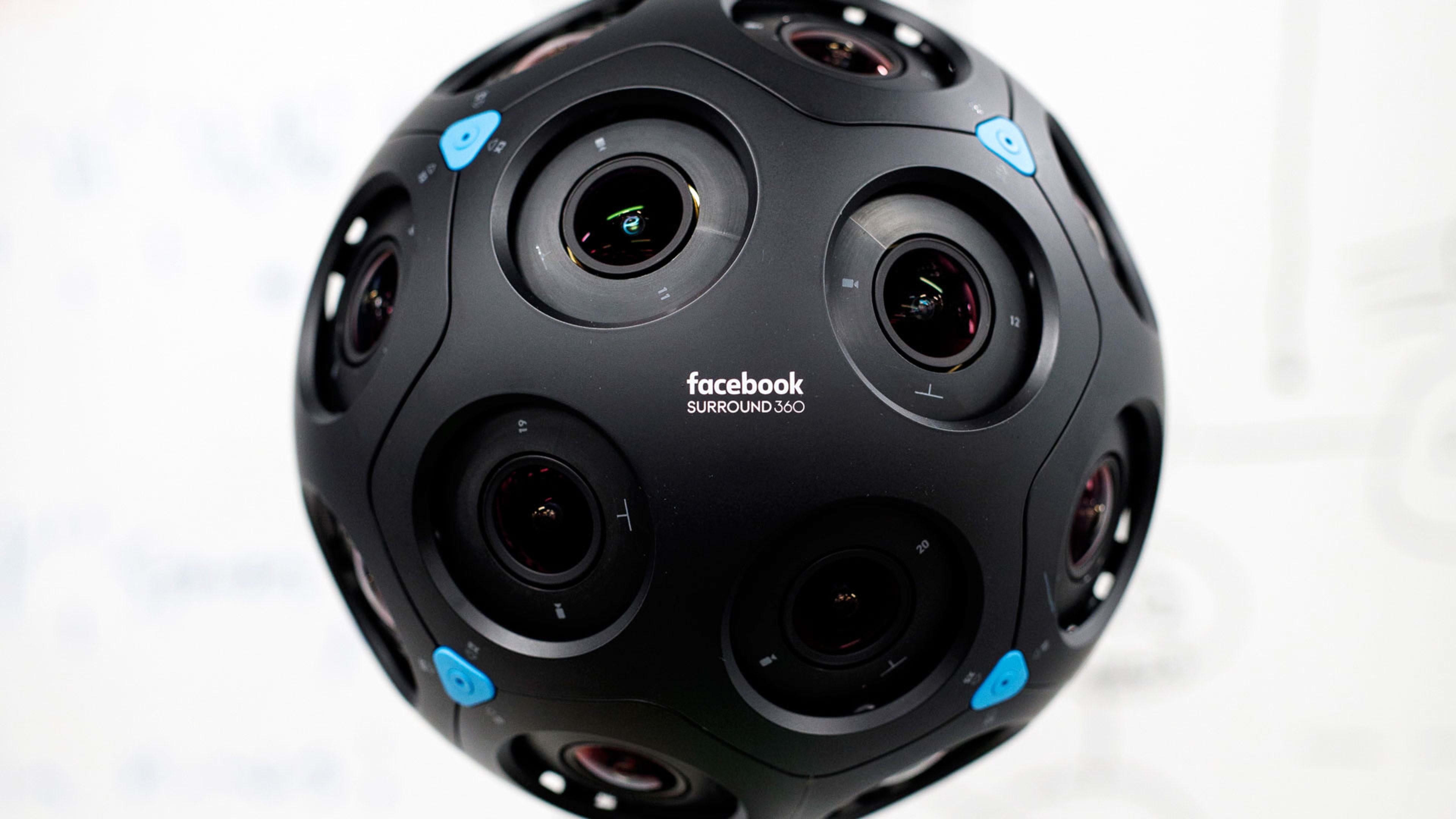Spencer Burns is standing in front of a huge five-axis milling machine, inside of which is a custom-designed tool behind glass, fiercely polishing metal at 11,000 RPM. Bits of shrapnel are flying fast and furious, and slowly but surely, a beautiful and smooth cylindrical shell is emerging from what just a few minutes ago was a solid 13-inch-by-13-inch-by-3-inch block of aluminum.
Burns, a CNC model maker at Facebook’s nascent Area 404 hardware lab, has been overseeing the prototyping of the company’s latest products—a pair of brand-new virtual reality camera rigs it developed (and that will be manufactured by licensed partners). Unlike any other cameras, they can shoot in what’s known as six degrees of freedom, or 6DOF, meaning in 360 degrees and in 3D.
The first camera, known as the x24, is meant for professionals making high-end projects, and features 24 lenses capable of shooting at extremely high resolutions. It was conceived in-house and the rugged, stylish outer shell was prototyped at Area 404, while Facebook turned to FLIR, a developer of thermal imaging cameras, to incorporate its lens-system integration into the x24’s 6DOF architecture.
At the same time, Facebook is also announcing a lower-end version, the x6, which has six lenses and shoots in a lower resolution, and was designed and prototyped entirely in house. Facebook isn’t yet saying who will produce either camera, nor what they will cost.
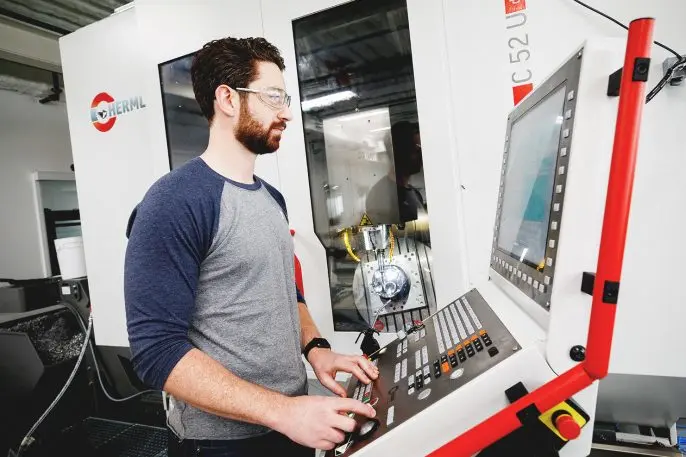
Why Six Degrees Of Freedom?
The upshot of 6DOF cameras? That users of high-end VR headsets like Facebook’s own Oculus Rift or HTC’s Vive will be able to move around in any direction in the footage it shoots rather than just be able to look around in 360 degrees from a fixed center position. Today, that’s largely only possible with computer-generated imagery or images shot using numerous cameras pointing inward. Or with expensive one-off cameras that aren’t designed to work easily with popular visual-effects and image-processing software.
“We want there to be tons of really great immersive content produced, so that people can have these amazing experiences that we want them to have in VR,” said Mike Schroepfer, Facebook’s CTO. “Virtual experiences can take you to places you’ve never been, like Mars or training to be a doctor in an emergency room, but video really opens up the opportunity for you to be in the real places in the world, seeing the Northern Lights or a family member.”
Created by the same team behind the reference design for Facebook’s $30,000 open-source Surround 360 camera last year, the sleek, black x24 is one of the most sophisticated hardware products Facebook has ever developed and the first commercially available product to emerge as a collaboration between Area 404 and numerous other parts of the company.
When Facebook formally unveiled Area 404 at a packed press event last summer, it still had that new hardware lab smell. Long workbenches were empty, dozens and dozens of electrical outlets were unclaimed, and though there was plenty of very expensive equipment on display–3D printers, 5-axis CNC milling machines, and the like–they were hardly in use.
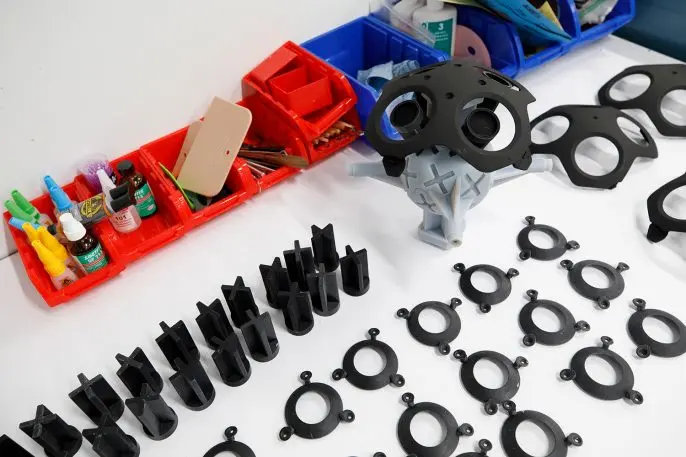
Once Spotless, Now Cluttered
Earlier this month, I was invited to be the first reporter to see the operation in action and to have exclusive access to the Area 404 folks leading the effort to turn out the x24 prototypes.
Now, the workbenches are covered in electronics and tools, there’s plenty of things plugged into the outlets, and the hard-core equipment is busy turning out work for various teams at Facebook eager to leverage their access to such an outfit. It’s “organized chaos,” Burns says. And why not? It’s open to anyone at the company wanting to pursue a hardware project.
In fact, said Schroepfer, Area 404 is now overbooked, forcing Facebook to open more hardware facilities to handle the demand.
Even as the Surround 360 team was still working on that first reference design last year, it was already conferring with Burns about how Area 404 could help make these new cameras–which the company believes will exist side by side in the filmmaking world with those based on last year’s open-source reference design–as powerful and robust as possible. And on a time scale that no outside prototyping organization could even come close to matching.
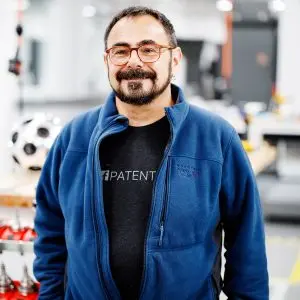
Even better, Cabral said, because imagery from the camera can be precisely mapped in 3D point cloud, it’s fairly simple to pair it with computer-generated 3D imagery, making visual-effects-driven cinematic films easier than ever to produce for VR systems like the Rift or Vive.
It also makes it possible for visual effects artists to do things like replace backgrounds as they normally would with a green screen, but without having to use a green screen, Facebook says.
And while the best imagery produced by the new cameras will be for systems like the Rift or Vive, they will also be able to produce high-quality 360-degree imagery for mobile VR headsets like Samsung’s Gear VR. When viewing content on that system, users are in the center of whatever they see and can look around them in all directions, but can’t move in three dimensions. Still, imagery produced with the new cameras for such gear looks fantastic, clear, and rich.

Big And Small
Asked why Facebook made the x24 and x6, Cabral pointed to the company’s core mission–connecting everyone to the memories and experiences they want to share. “That runs the gamut from people creating richly produced content to everyday content,” he said. “Given that [VR has] a completely new [visual] language, we wanted to make sure there’s a language to learn to share in this space…The people learning to communicate the language are the artists. They’re the first ones learning to capture, direct, and compose in 360.”
Eric Cheng, Facebook’s head of immersive media, said that at launch, the company has assembled a preliminary list of partners with whom it has been working on the camera. That list includes Adobe and Foundry, both makers of popular post-processing tools, as well as Otoy, a developer of software for making and distributing 3D content. “People will be able to use content from this camera in familiar tools,” Cheng said, “when it ships rather than having to struggle with new tools.”
At the same time, Cheng added, Facebook has also been working with VR and visual effects production companies like Here Be Dragons and FrameStore.
“The goal is to let you experience an environment or a story as immersively as possible, so that the technology fades away, and you’re left with the story,” Cheng said. “We’ve seen that in VR gaming already. This is a giant step for live action as well.”
Johannes Saam, the senior creative director at FrameStore, the visual effects house for films like “Guardians of the Galaxy 2,” agrees.
“The potential of Facebook’s [6DOF cameras] is incredible,” Saam said in a statement. “Its point-cloud-based approach paired with image overlap blurs the lines between 2D and 3D in the production pipeline and opens up the opportunities for advanced volumetric capture, [which] has the potential to be the next wave in cinematography. Being a part of creating this process and molding it into a modern production pipeline was very exciting.”
Collaboration
But before Saam or anyone else could get their hands on Facebook’s new cameras, there had to be collaboration between Cabral’s team and Area 404.
Burns said that his group had been involved in the camera design process “from concept all the way through the maturity of the mechanical and industrial design.”
In fact, he said, the camera was very much designed around Facebook’s in-house capabilities–meaning the kinds of things that could be prototyped using the professional-grade equipment available at Area 404. “It’s very complex to make,” Burns said. “It’s something only we can build. If we had tried to outsource [the production and iterative prototypes] it would have taken” months longer to get to where the project is today.
More to the point, Facebook would still have produced the camera, said design prototype staffer Joyce Hsu, but it would have likely had a significantly less ambitious or polished design. “We picked a design that is the perfect balance between function and form,” Hsu said.
Initially, the teams generated 3D-printed prototypes of the camera. Using those, they were able to identify issues that would come up in manufacturing.
Once they moved on to actually producing the rapid prototypes in the lab, they were able to rapidly iterate, Burns said, making steps forward on mechanical or industrial design elements “in hours or days, rather than weeks or months. That can only happen when you have a place like Area 404 and can bring” everyone together.
Jim Ammon, a mechanical engineer who worked on the camera project, noted that quick conversations with Burns and folks like Hsu allowed them to make design decisions in-house that likely saved days of work down the line. “It’s hard to do that,” Ammon said, “if you’re dealing with a remote [manufacturing] shop or a shop in another country.”
Still, building a camera like this in-house means not having anyone to lean on for advice or help. “There’s no playbook, and no rules,” Burns said. “There’s no one telling you how to make it. You just have to figure it out.”
One of Burns’s early epiphanies was to realize that he could utilize Area 404’s lower-end 3-axis milling machines to do some of the more brute-force work turning blocks of aluminum into the basic, semi-finished curved components that make up the camera’s outer shell.
That meant the lab’s top-end 5-axis milling machine was available for more sophisticated work. But because the lab has both devices, they could work on different aspects of the design at the same time, rather than being forced to do one or the other.
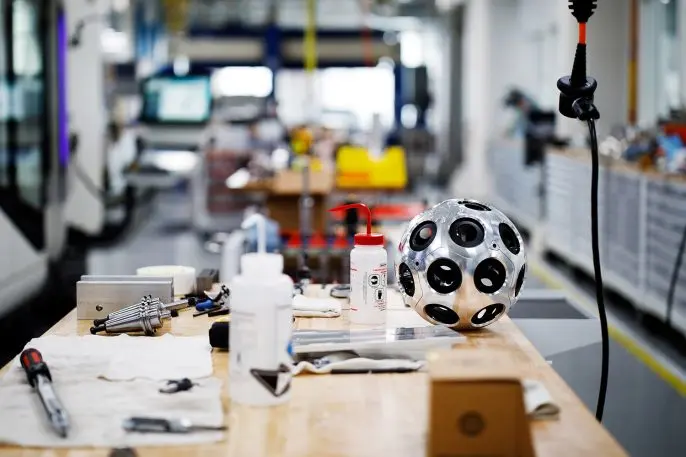
Handing Off The Hardware
Now that the designs are done, it’s time to turn them over to manufacturing partners. Facebook isn’t saying which companies it is working with, nor how much it expects the cameras to cost. Schroepfer said it’s fair to imagine that the x24–with 24 lenses–will cost more than last year’s camera, the design of which called for 17 lenses.
But the company is hopeful that professionals will see the value of a truly 6DOF camera rig designed to work seamlessly with the most popular editing and processing software. Already, Schroepfer said, numerous manufacturers have built cameras based on last year’s Surround 360 design. Now, it’s time to give the industry the tools to go even further, and Facebook expects filmmakers to be able to buy the cameras directly, or even rent them as needed. Either way, the more they’re used, the better off it is for Facebook, as a company making a major push into VR.
“We didn’t want to get into the camera business, we just wanted to make sure lots of people were able to produce this content,” he explained. “We’re trying to make it easier to bring whatever tools they want. And again, this is all toward [the goal of] if we get a lot more awesome immersive content being created and shared, we’ll give ourselves high-fives.”
Recognize your brand’s excellence by applying to this year’s Brands That Matter Awards before the early-rate deadline, May 3.
